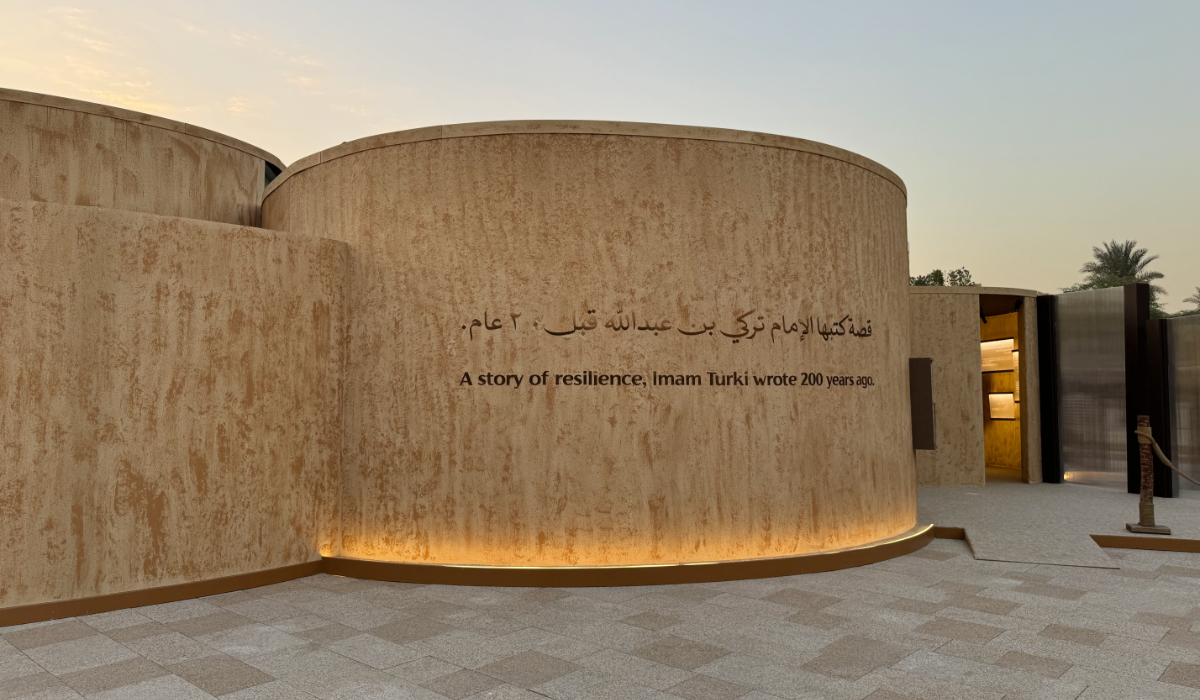RIYADH: Diriyah Season’s “Enduring Resilience” exhibition highlights the life of ruler Imam Turki bin Abdullah in celebration of the 200th anniversary of the establishment of the Second Saudi State.
“I enjoyed the exhibition. I honestly think that exhibitions like this are so important because they show Saudi history and the bravery of important people of the past, such as Imam Turki bin Abdullah,” said Maha Al-Aamri, a Saudi visiting the exhibition being held at Diriyah’s Bujairi Terrace with her friends.

Visitors were drawn to Turki’s Cave, created based on a cave Imam Turki strategically sought refuge in. (AN photo by Lama Alhamawi)
Speaking about what stood out to her, she said, “All of it … The storytelling about Al-Ajrab Sword was probably the best part of the exhibition.”
Al-Ajrab Sword is one of the most well-known symbols of the Kingdom’s history, representing the courage, determination, and nobility of Imam Turki in unifying and restoring the sovereignty of the Second Saudi State in 1824 when he entered Riyadh.
HIGHLIGHTS
• Al-Ajrab Sword is one of the most well-known symbols of the Kingdom’s history.
• It represents the courage, determination, and nobility of Imam Turki bin Abdullah in unifying and restoring the sovereignty of the Second Saudi State in 1824.
Through the exhibition, visitors are transported back in time through a guided and immersive journey that explores how Imam Turki established and shaped the Second Saudi State, reclaiming the land and restoring the legacy of his ancestors.

The exhibition takes visitors on a guided and immersive trip back in time as they explore the establishment and shaping of the Second Saudi State by Imam Turki. (AN photo by Lama Alhamawi)
“The experience was very nice and something different to try,” Vindeep Gupta, a computer technician working and living with his family in Riyadh, told Arab News.
“I will just say that I wish it (the exhibition) was bigger, but I like that it captured the struggles and challenges in achieving the victory … The historians did a good job in making the display,” he said.

The ‘Enduring Resilience’ exhibition transports visitors back in time through a guided and immersive journey that explores how Imam Turki bin Abdullah established and shaped the Second Saudi State. (AN photo by Lama Alhamawi)
Among the areas of the exhibition where visitors noticeably spent more time taking pictures and videos was Turki’s Cave.
According to a document published by the Diriyah Gate Development Authority, Imam Turki sought refuge in a cave high atop a rugged mountain, choosing it as his base of operations. The cave, located in Aliyyah, became one of the most well-known in Najd.

The exhibition takes visitors on a guided and immersive trip back in time as they explore the establishment and shaping of the Second Saudi State by Imam Turki. (AN photo by Lama Alhamawi)
Its inaccessibility made it a perfect hideout, strategically situated near several key towns and villages including Al-Kharj, Al-Houtah, Al-Hareeq, Al-Hulwah, and Al-Dalam.
The exhibition, in Arabic with English translation, is open to the public until the end of the year. It offers a deeper understanding of the values of unity, belonging, justice, and loyalty that were exhibited by the imams of the state.




































